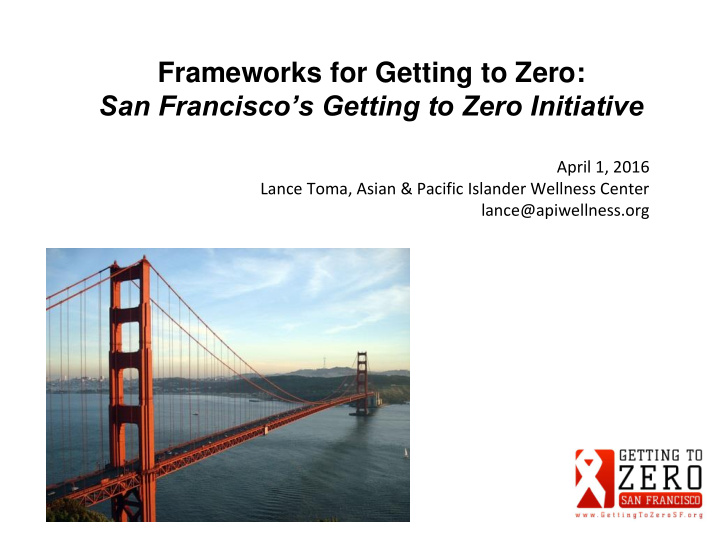



Frameworks for Getting to Zero: San Francisco’s Getting to Zero Initiative April 1, 2016 Lance Toma, Asian & Pacific Islander Wellness Center lance@apiwellness.org
How it began…. “This is all interesting, but are you working together ?” --Community member
Getting to Zero SF: What are we? • Multi-sector independent consortium – operates under principles of collective impact: “Commitment of groups from different sectors to a common agenda to solve a specific problem.” • Vision – Become the first municipal jurisdiction in the United States to achieve the UNAIDS vision of “ Getting to Zero ”
Collective Impact Collaborationforimpact.com
San Francisco Numbers Test, PreP and Treat, “San Francisco style”
HIV Care Cascade, SF
Committee Led Signature Initiatives 1. City-wide coordinated PrEP program 2. Rapid ART start with treatment hubs 3. Patient centered linkage, engagement, retention in care 4. Reducing HIV stigma Committee for each initiative is developing action plan, metrics and milestones, budget
Strategic priorities • Improve HIV for persons living with disease and at risk in San Francisco – Maintain funding for existing efforts – Achieve success in signature initiatives – Prioritize health equity • Secure funding and broad city/private sector support • Create innovative programs • Exchange best practices with other cities
Getting to Zero SF Infrastructure • Committee led signature initiatives • Co-chairs organize meetings, facilitate work, track metrics • Supported by a Steering Committee liaison • Sub-committees in larger initiatives (PrEP, Retention) • Quarterly Consortium Meetings • All are welcome – currently, 197 members strong • Hosted by San Francisco DPH • CAB component • Committee reports track initiative progress • Community initiatives/engagement key
Getting to Zero SF Infrastructure • G2Z Google Group facilitates broad communication • Website: GettingToZeroSF.org • Community feedback sessions on website development • Committees created page content • Integrated calendar highlights events • PrEP user group calendar and sign up • Blog feature for crowd-sourced information dissemination
Roadmap • 2013-4: Multisector, volunteer, community based organization, developed strategic plan and action committees for Getting To Zero • 2015: Launch of Getting to Zero- Investment of City and private sector; SFDPH Annual Report • 2015-2020 - Committee led initiatives (action), evaluation and coordination; collaboration locally and globally, broader engagement • 2020 – 90% reduction in new HIV infections and deaths
PrEP: 2016 Goals & Priorities • Create a sustainable city-wide model of delivery – Build capacity – Enhance funding – City-wide PrEP Navigators • Reach those populations that are currently underserved – Expand and diversify Ambassador program – Reach into neighborhoods and community organizations • Monitor our progress and use data to inform strategies and decisions – Integrate data from diverse sources
PrEP: 2016 accomplishments • PrEP navigators at 3 DPH clinics, 3 CBO awards • CDC grant: $1.9 million/year x 3 years for PrEP scale-up, outreach with emphasis on people of color and trans • Building capacity: – Provider trainings and materials – PrEP integrated into primary care, high capacity at Ward 86, STRUT, Kaiser • Building awareness – Launched “Please PrEP Me” to link people with providers – Launching PrEP ambassador & outreach program – Training all HIV test counselors • PrEP digital storytelling training for young MSM & transwomen • Building tracking system to measure impact
RAPID: Rapid ART Program Initiative for HIV Diagnosis • Demonstrated significant improvement in time from diagnosis to viral suppression (from 4.2 months to 1.9 months) – Improves health of treated person – Reduces risk of transmission • 2015 Progress – Establish increased counselor capacity for city wide RAPID – Provider awareness: HIV testing sites, HIV primary care sites – Clinical SOP for rapid start-up of ART – Ensure emergency ART drug supply – Sharing program and practices with other cities – Evaluation of outcomes and refinement of processes
Retention & Re-Engagement • Two half day retreats attended by 40 – mapping gaps in retention and re-engagement in care – prioritizing 2016 activities • CDC grant: $958,000/year x 3 years for retention – Create systems to use surveillance data to identify people out of care • MAC AIDS: $500,000 (potentially renewable) for retention – Retention navigators at clinics for appt reminders, quick recognition of drop out of care, outreach and wraparound services to re-initiate care • Digging into data on overdoses, suicides, then all deaths – Find what is preventable; create strategies to address
Ending Stigma • Recently formed committee, ensuring diversity • Planning inventory of current tools, surveys of HIV and PrEP stigma • Planning community-wide needs assessment • Linkage with national programs (Sero Project) • Staffing PrEP, RAPID, and Retention Committees
Recommend
More recommend